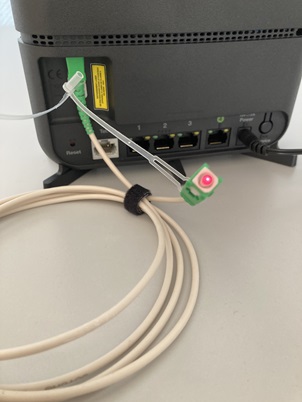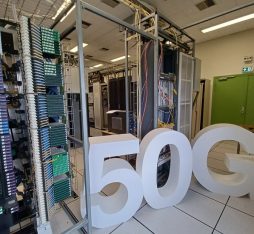• With the optical pencil embedded in the latest generation of Orange boxes, a bright red flashing light helps to identify customers’ fibres to make installation easier and to identify any disconnections at a glance.
Because it occurs in near-infrared or infrared wavelengths, the light used in optical fibres to transport data is invisible to the naked eye. If a problem is escalated by an Orange customer in France, a technician must travel to the customer’s home and use a portable optical pen, a device that emits a ray of light along the fibre to reveal continuity faults related to bends or breaks. During installation, this pen is used to identify the customer’s fibre so it can be properly connected to the , one of the key links in the optical communication chain.
When necessary, the embedded optical pencil produces a visible red light that glows along the customer’s fibre
Livebox S sees red
These installation or troubleshooting procedures may be inconvenient for both the customer and the technician in terms of time, travel, availability etc. To avoid these issues, Orange’s innovation teams decided to explore an alternative route by designing an optical pencil embedded natively in the boxes. It is the new Livebox S[1] that benefits from this pioneering technical development. Cyril Del Missier, Livebox Product Line Manager at Orange, explains the aim: “It was about getting the box itself to emit a light signal. When necessary, the embedded optical pencil flashes a red light, visible to the human eye—with a specific flash, different from that of the optical pens on the market—which glows along the fibre. This means that the technician can easily identify the right line to connect to during installation or detect a break in the fibre path, without having to go to the customer’s home.”

The visible and the invisible working together
To achieve this innovation, Orange worked with Arcadyan, a Livebox S supplier, to add a wavelength to the bidirectional optical sub-assembly (BOSA) component. It traditionally runs two wavelengths—in the infrared spectrum and therefore invisible—for transmitting and receiving the signal. With the optical pencil, a third visible colour is added to and supported by this module.
The choice of red is not by chance: beyond being visible to the naked eye, this colour also travels the farthest in an optical fibre. The intensity of the light generated by the pencil, which is comparable to that of an LED, is designed to be safe for the eyes. “The ray can cover a distance of up to five kilometres,” adds Vincent Le Goff, Livebox S Technical Manager at Orange. “This means we can respond to 95% of customer cases relating to the distance between the box and the pooling point. Finally, the flash of light is activated by an intelligent system: the box triggers the optical pencil only when it detects the absence of a signal.”
Simplifying and speeding up customer and technician experiences
This new system is starting to encounter real world usage and operating conditions. It is already hinting at tangible benefits in terms of user experience and operations. The optical pencil means there is no need for installation or troubleshooting appointments, saving time for customers and technicians. By preventing inconvenient travel to customers’ homes, the optical pencil could also help to reduce CO2 emissions relating to technicians’ work.
This device could be used for more than just residential connectivity, for example identifying fibres in data centres.
[1] The Livebox S has been available since 10 April 2025 as part of the Livebox Fibre and Livebox Fibre Special Series offerings.
Optical pencil: simple transmission of information :
Only just out of the laboratories, the optical pencil is subject to fresh innovation aimed at studying the feasibility of a customer authentication application.
The objective is to adapt the red light emitted by the pencil with a small volume of data corresponding to the customer identifier or the box’s serial number. Using a smartphone, the technician could decrypt and read this frame of information to ensure that the line and the customer match.
One of the constituent parts in a fibre optic network. Located just outside or within a building, or in the street, the pooling point receives the optical signal and distributes it to a group of homes.
A key component of optical communication systems that supports two-way communication by combining optical signal transmission and reception capabilities.











